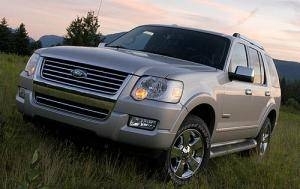
Brakes start out working great, but over time, they often fade out as the pads and rotors begin to wear down. Replacement of the pads may be obvious, but many times the rotors will need to be replaced as well. As the pads and rotors rub together over time, they develop grooves. This works fine, because the grooves on the pads match the ones on the rotors. The problem occurs when new pads are put on, and the grooves no longer match the smooth surface of the pads.
Changing brake rotors sounds more complicated than it really is, and the ones on your Ford Explorer can be replaced in a couple of hours by a medium level do-it-yourself mechanic.
Jack the vehicle up using a floor jack, and support its weight using jack stands. Reference the vehicle's manual for specific jack points. Make sure the Explorer is in park and the emergency brake is engaged. Chock the opposite wheels to ensure the vehicle doesn't move. Using a tire iron or a socket set, remove the lug nuts from the jacked up wheels. Lay the wheels on their side, and slide them under the jacked up frame. This will allow them to function as a last-minute stop in case the jack stands fail.
Pop the hood, and open the filler reservoir where you would normally add brake fluid. Using a turkey baster or a similar device, remove about 1/3 of the container's fluid content, and leave the cap off. This will allow expansion room as fluid backs up into the container when the brake caliper is compressed. Store the fluid in a clean container so it can be reused to fill the container back up once the job has been completed.
Place a C-clamp around the brake caliper so that it makes contact with both sides of it. Tighten the clamp by hand, until you can tighten it no further. This will be enough to compress the brake caliper and lock it into place, freeing it for removal. At this point, you can loosen the clamp and set it aside. Examine the caliper, and you will see several bolts that hold it in place. Remove these, and the caliper will be free to slide off. Be cautious at this point, since the brake line is still attached. Carefully set the caliper aside, being careful not to disturb the still-connected brake line.
The rotor is now free to slide off. If it has been a long time since your last change, the rotor may be slightly rusted to the hub of your Explorer. If that is the case, tap it gently from behind using a rubber hammer until it is free and able to slide off. Lay the old rotors aside, and replace them with new ones. The new rotors slide into place in the same way that the old ones came off. Spray both sides of the rotor with a brake cleaning spray. This will ensure no oils are left behind that could prevent proper braking performance.
Slide the brake caliper system back into place where it surrounds the brake rotor, again being careful of the brake line. Insert the bolts back into the caliper and tighten them down all the way. Replace the wheel and tighten the lug nuts back into place. Pour the brake fluid back into the reservoir, and take the Explorer for a drive around the block to make sure everything functions properly. Test the brakes several times in the driveway before setting off.